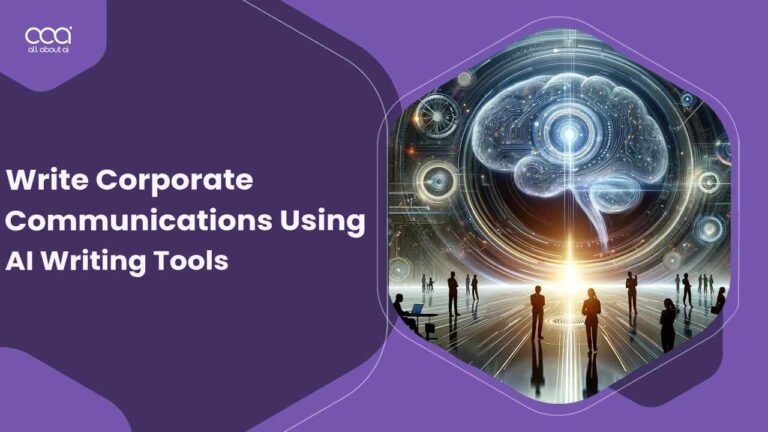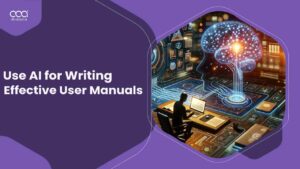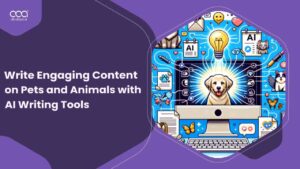In the digital age, mastering ‘How to Use AI Tools for Writing Effective Corporate Communications in France?’ is essential for businesses seeking to stay ahead.
With the integration of best AI writing tools in France into corporate communication strategies, companies can achieve unprecedented efficiency and personalization.
This advancement is more than a convenience; it’s a necessity in today’s fast-paced corporate world, solidifying the role of the best AI writing tools in effective communication management.
How to Use AI Tools for Writing Effective Corporate Communications for 2024 in France ?- Step-By-Step Guide
I’ve explored AI extensively and created a guide to show you the steps for using AI tools effectively in corporate communications.
Example Scenario: A company is launching a new eco-friendly product line and wants to use ChatGPT for various aspects of corporate communication related to this launch.
Step 1: Define Your Communication Objectives
This step involves clearly defining the specific goals and outcomes you wish to achieve with your communication. Objectives could range from raising awareness about a new product and educating employees about a policy change to engaging with stakeholders on social media. A clear understanding of these objectives guide the AI in generating relevant and strategically aligned content.
Practical Example:
I asked ChatGPT to help outline clear objectives for our eco-friendly product line launch. We focused on objectives like raising environmental awareness and highlighting product benefits.

Step 2: Choose the Right AI Writing Tool
Select an AI tool that matches the specific requirements of your communication task. AI tools vary in their capabilities, such as formal business writing, creative storytelling, or data analysis. Matching the tool’s strengths with your needs ensures appropriate content in style, tone, and complexity.
Practical Example:
I consulted ChatGPT to determine the best AI writing tool for creating engaging and informative content for our product launch, considering the need for both creativity and factual accuracy.

Step 3: Tailor AI Suggestions to Your Corporate Voice
Refine AI-generated content to align with your company’s unique voice and branding. Edit and modify the AI output for consistency with your corporate communication style, terminology, and values.
Practical Example:
I first requested ChatGPT to create a preliminary draft for an article to announce the launch of our new line of products. As an example, I referred to our products as “Go Green Products” and selected “Alpha Group” as the name of our company.
Then I refined the draft to ensure they matched our brand’s tone – emphasizing our commitment to sustainability and customer well-being.

Then I refined the draft to ensure they matched our brand’s tone – emphasizing our commitment to sustainability and customer well-being.

Step 4: Use AI for Data-Driven Audience Analysis
AI tools can sift through large amounts of audience data, such as social media interactions, website visits, and customer feedback. By analyzing this data, AI can uncover patterns and preferences in audience behavior, which might not be immediately obvious.
Practical Example:
I used ChatGPT to analyze customer feedback on our previous eco-friendly initiatives. This helped tailor our messaging to address common questions and concerns about sustainability.

Step 5: Implement AI for Language and Tone Optimization
AI algorithms can analyze and suggest adjustments to the language and tone of your content, ensuring it’s appropriate for different audiences and contexts. This might involve making language more formal or casual, using industry-specific jargon, or adjusting the tone to be more empathetic or authoritative, depending on the audience.
Practical Example:
First, I requested ChatGPT to create promotional content for our environmentally friendly products, tailored for various platforms.
I asked ChatGPT to fine-tune the language of our marketing materials, making sure they were accessible yet persuasive, and aligned with our eco-friendly ethos.

Step 6: Ensure Compliance and Fact-Checking with AI
AI tools can be employed to check the accuracy of facts and compliance with legal and regulatory standards. This is especially important in industries like finance, healthcare, and law where misinformation or non-compliance can have serious consequences.
Practical Example:
To ensure all claims about our eco-friendly product line were accurate and compliant with environmental regulations, I used ChatGPT for fact-checking and cross-referencing with legal standards.

Step 7: Continuously Update and Train the AI
To maintain its effectiveness, an AI system must be regularly updated with new information and feedback. This ensures that the AI remains aligned with evolving communication styles, terminologies, and audience expectations.
Practical Example:
I kept feeding ChatGPT new information about the product line and customer feedback, ensuring that its suggestions remained relevant and effective as the campaign progressed.

Step 8: Evaluate and Refine AI-Generated Content
AI-generated content should be reviewed and refined by humans to ensure it meets quality standards and authentically represents the brand’s voice. While AI can generate drafts, the human touch is necessary for adding nuance and ensuring the content resonates with the audience.
Practical Example:
After ChatGPT helped draft a press release, I added specific case studies and quotes from our CEO to enhance its authenticity and align it more closely with our brand narrative.

Step 9: Use AI for Multilingual and Cross-Cultural Communications
AI can assist in translating and culturally adapting content for different regions. This ensures that communications are not only linguistically accurate but also culturally sensitive and relevant.
Practical Example:
For our international audience, I used ChatGPT to translate and culturally adapt our campaign materials, ensuring they resonated well in different markets.

Step 10: Leverage AI for Real-Time Communication Analysis
AI can analyze communications in real-time, providing instant insights into audience reactions and engagement. This can be particularly useful in dynamic situations like live events, social media monitoring, or customer service interactions.
Practical Example:
During the product launch, I used ChatGPT to analyze real-time social media feedback, allowing us to quickly adapt our communication strategy to audience reactions.

Understanding Corporate Communications
Corporate communications involve managing and orchestrating all internal and external communications aimed at creating a favorable perception among stakeholders.
This comprehensive approach encompasses various aspects of communication, including public relations, crisis management, and employee engagement, and is vital for maintaining the brand’s reputation and identity.

Scope of Corporate Communication
In today’s fast-paced business world, Corporate Communication stands as a vital tool, skillfully blending words and strategies to build and maintain a robust corporate image.

Brand Management:
Corporate communication serves as the guardian of a brand’s identity. It’s not just about logo and color scheme; it’s about crafting a story that captivates and connects with an audience.
Through targeted campaigns, consistent messaging, and a keen understanding of market trends, corporate communication shapes how a brand is perceived in the public eye. Whether launching a new product or redefining an existing one, every message is an opportunity to reinforce the brand’s values and vision.
Internal Communication:
The backbone of any successful company is its workforce, and effective internal communication is the key to keeping this backbone strong. More than just memos and emails, it’s about creating an open dialogue where ideas flow freely and information is shared transparently.
This can involve regular newsletters, town halls, or digital platforms that encourage interaction. When employees are well-informed and feel heard, they are more engaged, motivated, and aligned with the company’s objectives, ultimately driving productivity and innovation.
Crisis Management:
When a crisis hits, the clarity and speed of corporate communication can make all the difference. This aspect of communication is all about preparation and response. It involves developing crisis management plans, training spokespersons, and establishing communication channels that can be activated swiftly.
In a crisis, the aim is to provide accurate information, maintain transparency, and show empathy to affected stakeholders. A well-handled crisis can not only mitigate immediate damage but also strengthen trust and credibility in the long term.
Stakeholder Engagement:
This facet of corporate communication revolves around understanding and managing the expectations of various stakeholders, including investors, customers, employees, and the community.
By actively listening to their concerns and feedback, a company can foster strong relationships and loyalty. Engaging with stakeholders through regular updates, participation in community events, and social responsibility initiatives not only enhances the company’s reputation but also provides valuable insights for business growth and development.
Media Relations:
Effective media relations are pivotal in shaping the public narrative about a company. This involves not just responding to media inquiries but also proactively seeking opportunities to tell the company’s story through press releases, interviews, and media events.
The goal is to establish a positive and consistent image in the public domain, manage the flow of information, and position the company as a thought leader in its industry. Nurturing good relationships with journalists and influencers can be invaluable, especially in times of crisis or when launching new initiatives.
Importance of Clarity and Professionalism
Clarity and professionalism in corporate communications are critical for ensuring that messages are accurately conveyed and positively received, reinforcing the company’s credibility and reliability.

Ensuring Message Clarity
Clear communication is vital in corporate contexts to prevent misunderstandings, ensuring stakeholders accurately receive and interpret messages, thus enhancing effective decision-making and collaboration.
Building and Maintaining Trust
Professional communication is essential in nurturing trust among stakeholders, fostering long-term relationships, and cementing brand loyalty through consistent, transparent, and reliable messaging.
Effective Crisis Management
In crisis situations, clear and professional communication is crucial for effective management, maintaining public trust, and mitigating potential reputational damage through timely and accurate information dissemination.
Influencing Employee Morale
Clear, professional internal communication significantly impacts employee morale and engagement, fostering a positive workplace culture and enhancing overall productivity and job satisfaction.
Upholding Company Image
Professional communications reflect a company’s values and standards, playing a crucial role in reinforcing a positive corporate image and reputation among stakeholders and the public.
Brief Overview of AI’s Role in Corporate Communications
AI is revolutionizing the landscape of corporate communication by introducing automation, advanced analytics, and personalized content creation. These innovations are reshaping how businesses communicate with customers, employees, and stakeholders.

Enhancing Efficiency
AI tools streamline communication processes, allowing businesses to respond quickly and manage large volumes of interactions. This efficiency is key to maintaining timely and effective communication in today’s fast-paced business environment.
Personalization at Scale
AI enables businesses to tailor their communications to specific audience segments. This personalization makes the messages more relevant and engaging, greatly enhancing the effectiveness of communication efforts.
Data-Driven Insights
AI provides deep analytics, offering invaluable insights into audience behaviors and preferences. These insights are crucial for developing communication strategies that are both targeted and impactful, leading to more successful outcomes.
Consistency and Branding
AI helps maintain a consistent tone and style across various communication channels. This consistency is vital for preserving brand identity and ensuring a cohesive and professional corporate image.
Best Practices for Using AI Tools in Corporate Communications

Incorporating Human Oversight:
Human supervision in artificial intelligence (AI) communications is indispensable. It ensures the content is accurate, reflects the company’s ethical standards, and aligns with its strategic goals. This oversight is key in mitigating risks associated with AI’s limitations, such as misunderstanding context or misrepresenting subtle language nuances.
Essential for Context and Nuance:
Human intervention is crucial in imparting context and nuance to AI-generated messages. This human touch ensures that communications are culturally attuned and sensitive, conveying emotions and subtleties appropriately.
Especially in a global context, humans can adeptly navigate cultural nuances and idiomatic expressions, ensuring messages are received as intended and avoiding potential misunderstandings that could arise from AI’s limitations in understanding complex human interactions.
Checking Against AI Biases:
Frequent human oversight is essential to detect and correct biases in AI-generated content. This step is vital for ensuring communications are equitable and unbiased, reflecting the company’s commitment to diversity and inclusivity.
Human review helps in identifying subtle prejudices that AI might inadvertently perpetuate, ensuring that messaging aligns with ethical standards and promotes a positive, inclusive corporate image.
Alignment with Company’s Tone:
It is imperative that AI communications align with the company’s unique tone and style. Human involvement ensures consistency in the brand’s voice across various platforms, reinforcing trust and recognition among stakeholders.
This alignment is key in maintaining a cohesive brand identity, as humans can fine-tune AI outputs to match the company’s established communication style, ensuring that all messages are on-brand and resonate with the intended audience.
Balancing AI with Creativity:
Combining AI’s efficiency and data-processing abilities with human creativity leads to more dynamic and engaging corporate communications. This synergy allows for the creation of innovative content that better connects with audiences.
Humans bring a creative edge that AI lacks, infusing communications with originality and flair that resonates more profoundly with recipients, enhancing the overall impact and effectiveness of the messaging.
Adapting to Audience Feedback:
Human involvement is key in adapting communications based on audience feedback. AI can process large volumes of data, but humans are needed to interpret this feedback in a nuanced manner.
This process involves understanding subtle cues and making adjustments that AI might not discern. By actively incorporating feedback, communications become more targeted and effective, enhancing customer engagement and satisfaction.
Balancing AI Output with Original Content
Learn how to blend AI’s efficiency with your unique ideas for engaging messages, tackling the concept of “How to Use AI Tools for Writing Effective Corporate Communications in France?” Let’s take a deeper look into this effective integration:

Maintaining the Human Element:
Blending AI-generated content with human elements is critical for preserving the authenticity and relatability of corporate communications. This approach ensures that messages are not only efficient and data-driven but also resonate on a personal level with the audience.
Ensuring Authenticity in Messaging:
Authenticity is key in corporate communications. Human input in AI-generated content ensures that messages are genuine, fostering trust and credibility with the audience, which is essential for long-term engagement and loyalty.
Preventing Generic Responses:
Combining AI with human creativity prevents the creation of generic, one-size-fits-all responses. Tailored and relevant communications are more effective in addressing specific audience needs and concerns, enhancing the overall impact of the message.
Encouraging Creative Input:
Involving communication professionals in the AI content creation process encourages innovative thinking and strategic planning. This collaboration leads to more diverse, impactful, and strategically aligned messaging.
Strengthening Brand Identity:
Unique human contributions, alongside AI-assisted outputs, play a crucial role in reinforcing and enhancing the brand’s identity. This blend helps in differentiating the brand in a competitive marketplace, creating a distinct corporate voice.
Practical Applications of AI in Corporate Communications
Discover the Practical Applications of AI in Corporate Communications, where technology meets strategy to revolutionize how businesses engage with audiences, manage information, and streamline their messaging processes.

Company-wide Updates Using AI:
AI tools can efficiently draft and distribute uniform updates across a company, ensuring that all employees, regardless of location or department, receive consistent, timely, and accurate information. This uniformity is crucial for maintaining coherent internal communication.
Investor Relations Updates:
AI tools are adept at synthesizing complex financial data and market trends. They can provide comprehensive, easy-to-understand updates for investors and stakeholders, enhancing transparency and trust in the company’s financial communications.
Email Composition for Coworkers and Superiors:
AI can assist employees in crafting clear, concise, and professional emails. This improves internal communication efficiency and professionalism, reducing misunderstandings and increasing productivity in workplace interactions.
AI-Driven Customer Support:
AI-powered chatbots provide real-time, efficient customer support. They handle routine inquiries, offer information promptly, and can escalate more complex issues to human representatives, improving the overall customer experience.
Content Creation and Curation:
AI aids in creating and curating engaging content for corporate communications. It ensures the content is relevant to the target audience, aligned with current trends, and strategically tailored to achieve corporate communication goals.
Challenges and Considerations of Using AI in Corporate Communications
Integrating artificial intelligence into corporate communications poses unique challenges. Addressing “How to Use AI Tools for Writing Effective Corporate Communications in France?” is crucial. Let’s explore common issues like aligning AI with company tone, ensuring authenticity, and understanding audience needs.

Authenticity and Tone of Voice:
Maintaining an authentic tone in AI-generated content is vital to ensure it reflects the company’s brand identity and resonates effectively with the audience. This challenge involves fine-tuning AI outputs to match the unique voice and style of the company.
Legal and Ethical Considerations:
Deploying AI in corporate communications requires adherence to legal and ethical standards. Companies must navigate data privacy laws, intellectual property rights, and ethical guidelines to maintain public trust and avoid legal complications.
Accuracy and AI Hallucinations:
Ensuring the accuracy of AI-generated content is crucial to avoid spreading misinformation. Companies need to be vigilant about AI “hallucinations” – instances where AI presents fabricated or inaccurate information as fact.
Integration with Existing Systems:
Integrating AI tools with existing communication systems and workflows can be challenging. It requires careful planning and execution to ensure that AI tools complement and enhance existing processes without causing disruptions.
Training and Adaptation:
AI tools need continuous training and adaptation to remain effective. This involves updating the AI with new data, adjusting algorithms in response to changing communication strategies, and ensuring the AI remains aligned with the evolving needs of the company.
What Future Trends Are Expected in AI in Corporate Communications?
Emerging trends in artificial intelligence are set to revolutionize how to use AI tools for writing effective corporate communications in France. This innovation spans from enhancing personalization to improving analytics, shaping a future where technology and human interaction merge seamlessly.
Enhanced AI Algorithms:
Future advancements in AI will likely bring more sophisticated algorithms capable of understanding and generating more nuanced and effective corporate communications. These advancements could include better understanding of context, tone, and audience-specific needs.
Greater Strategic Integration:
AI will become more deeply integrated into strategic decision-making processes in corporate communications. This integration will provide data-driven insights, enabling more informed and targeted communication strategies.
AI-Driven Personalization:
With future developments, AI will likely offer even more personalized corporate messaging. This will involve tailoring communications based on individual customer preferences, behaviors, and previous interactions, thereby enhancing engagement and customer experience.
Ethical Guidelines and Standards:
As AI becomes more prevalent in corporate communications, the development and adherence to ethical guidelines and standards will become increasingly important. This will ensure the responsible use of AI, protecting user data and privacy.
Improvement in Natural Language Generation:
Continuous advancements in natural language generation technologies will enable AI to produce more human-like, relatable, and effective communications. This will enhance the engagement and effectiveness of AI-generated corporate messages.
Get More Inspiration: Explore these How-to Guides Too:
Learn more about the best AI writing tools by going through these how-to-guides as well:
FAQs
Here are some of the most commonly asked questions about “how to use AI Tools for writing effective corporate communications in France?”
How is AI used in corporate communications in France
?
How to use AI for internal communications?
How artificial intelligence will impact corporate communications?
Do AI writing apps support communication skills?
Conclusion
AI tools are rapidly becoming integral to corporate communications, offering unmatched efficiency, personalization, and insights. However, it’s crucial to balance these benefits with considerations of authenticity, legal and ethical aspects, and the need for human oversight.
In this guide of “How to Use AI Tools for Writing Effective Corporate Communications in France?” we have thoroughly reviewed how advanced technology is revolutionizing every knock and corner of the organizational setting.
To learn more about how to use best AI writing tools in different fields and domains, do check out more articles in our “How-To Guides” or you can enhance your AI knowledge, by understanding different AI terminologies from our AI Knowledge Book.





